Tt 33 Vs 1911 Size Comparison Airsoft
Tt 33 Vs 1911 Size Comparison Airsoft
| TT (Tula Tokarev) | |
|---|---|
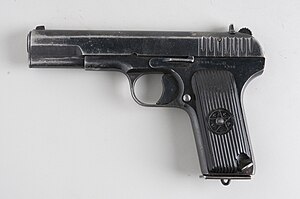 TT-33 | |
| Type | Semi-automatic pistol |
| Place of origin | Soviet Union |
| Service history | |
| In service | 1930–nowadays |
| Used by | Run into Users |
| Wars | Spanish Civil War Earth War II Korean War[1] Chinese Ceremonious State of war Arab–Israeli conflict[2] Bangladesh Liberation State of war[3] Vietnam War Laotian Civil State of war Hungarian Revolution of 1956[4] Cambodian Civil War Cambodian-Vietnamese State of war Sino-Vietnamese War Soviet–Afghan War Gulf War Yugoslav Wars Burundian Civil State of war Cambodian–Thai border stand-off War in Afghanistan (2001–present)[v] Syrian Ceremonious War War in Donbas[half-dozen] |
| Production history | |
| Designer | Fedor Tokarev |
| Designed | 1930 |
| Manufacturer | Tula Arms Found, Izhevsk Armory, Norinco, Femaru, FB Radom, Cugir Arsenal, Zastava Arms, FÉG |
| Produced | 1930–1955[7] |
| No. built | one,330,000 |
| Variants | TT-xxx, TT-33, TTC, M48, M48 Tokagypt, M57, M70, M70, R-three, Type 51, Type 54, Type 68, K-14 |
| Specifications | |
| Mass | 854 thousand (thirty.1 oz) |
| Length | 194 mm (7.vi in) |
| Barrel length | 116 mm (four.half dozen in) |
| Height | 134 mm (5.3 in) |
| | |
| Cartridge | 7.62×25mm Tokarev 9mm Parabellum |
| Action | Short recoil actuated, locked breech, single action |
| Cage velocity | 450 yard/s (one,476 ft/s) |
| Effective firing range | 50 chiliad |
| Feed system | 8-circular detachable box magazine or 9-round detachable box magazine compatible with Zastava M57 |
| Sights | Front bract, rear notch 156 mm (6.ane in) sight radius |
The TT-30,[a] unremarkably known but as the Tokarev, is an out-of-production Soviet semi-automatic pistol. Information technology was developed in the early 1930s by Fedor Tokarev equally a service pistol for the Soviet armed services to replace the Nagant M1895 revolver that had been in employ since the Russian Empire, though information technology ended up being used in conjunction with, rather than replacing, the M1895. It served until 1952, when information technology was replaced by the Makarov pistol.
Development [edit]
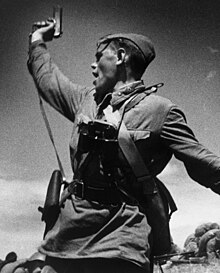
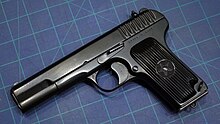
Soviet Tokarev TT-33, fabricated in 1937
In 1930, the Revolutionary Military Council approved a resolution to test new pocket-sized arms to supplant its aging Nagant M1895 revolvers.[8] During these tests, on seven January 1931, the potential of a pistol designed by Fedor Tokarev was noted. A few weeks later, i,000 TT-30s were ordered for troop trials, and the pistol was adopted for service in the Blood-red Regular army.[9] The TT-thirty was manufactured between 1930 and 1936, with about 93,000 beingness produced.
Even equally the TT-thirty was being put into production, design changes were made to simplify manufacturing. Minor changes to the butt, disconnector,[10] trigger and frame were implemented, the most notable ones being the omission of the removable hammer assembly and changes to the total-circumference locking lugs. This redesigned pistol was the TT-33.[9] Most TT-33s were issued to commanding officers. The TT-33 was widely used by Soviet troops during Earth State of war II, only did not completely supervene upon the Nagant. From 1931-1945, a total of 1,330,000 Tokarevs were produced in the Soviet Matrimony.[11]
Design details [edit]
Externally, the TT-33 is very similar to John Browning's blowback operated FN Model 1903 semiautomatic pistol, and internally it uses Browning's short recoil tilting-butt system from the M1911 pistol. In other areas the TT-33 differs more from Browning'southward designs—it employs a much simpler hammer/sear assembly than the M1911. This associates is removable from the pistol as a modular unit and includes machined magazine feed lips, preventing misfeeds when a damaged mag was loaded into the magazine well.[12] Soviet engineers made several alterations to make the mechanism easier to produce and maintain, most notably the simplifications of the barrel's locking lugs, assuasive fewer machining steps. Some models use a captive recoil spring secured to the guide rod, which does depend on the butt bushing to hold information technology under tension. The TT-33 is chambered for the seven.62×25mm Tokarev cartridge, which was itself based on the similar 7.63×25mm Mauser cartridge used in the Mauser C96 pistol. The seven.62×25mm cartridge is powerful, has an extremely apartment trajectory, and is capable of penetrating thick clothing and soft body armor. Because of their reliability, big numbers of the TT-33 were produced during World War II and well into the 1950s. In modern times, the robust TT-33 has been converted to many powerful cartridges including .38 Super and 9×23mm Winchester. The TT-33 omitted a safety catch other than the half cock notch, which rendered the trigger inoperable until the hammer was pulled dorsum to full erect and then lowered manually to the half cock position. Many imported variants take manual safeties added, which vary greatly in placement and function.
Variants [edit]
The Wehrmacht captured TT-33s and issued them to units nether the Pistole 615(r) designation. This was made possible by the fact that Russian 7.62 mm Model 1930 Blazon P cartridges were most identical to the German 7.63×25mm Mauser cartridge, although in German service the 9×19mm Parabellum circular was more common. Due to much higher pressures, using Russian cartridges in German language Mauser pistols can induce damages, and is advised against.[12]
Interarms marketed Globe War II–surplus Russian-fabricated Tokarevs in Europe and the United States every bit the Phoenix. They had new wooden grips with a phoenix design on them and were overstamped INTERARMS on the barrel. Later gun laws banned their sale due to their lack of a safety.[ commendation needed ]
In 1949, a silenced variant was produced. Uniquely, the silencer is attached to the butt bushing rather than the barrel itself. The combined weight of the suppressor with the slide prevents semi-auto cycling of the action, forcing the user to manually cycle it in the aforementioned manner as pump activity firearms. It would afterward be replaced by the Pb pistol in 1967.
Strange product [edit]
The TT-33 was eventually replaced by the 8-round, 9×18mm Makarov PM pistol in 1952. Production of the TT-33 in Russia ended in 1954, but copies (licensed or otherwise) were also fabricated by other countries. At one time or another, almost communist or Soviet bloc countries fabricated a variation of the TT-33 pistol.
China [edit]
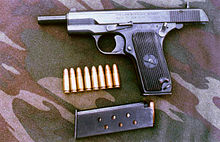
Blazon 54 with manual safety
The TT pistol was copied in China equally the Type 51, Type 54, M20, and TU-90.[13]
Norinco, the People'due south Liberation Army'due south land armaments manufacturer in China, manufactured a commercial variant of the Tokarev pistol chambered in the more common 9×19mm Parabellum round, known as the Tokarev Model 213, as well equally in the original 7.62×25mm caliber.
The 9mm model features a condom grab, which was absent on Russian-produced TT-33 handguns. Furthermore, the Model 213 features the thin slide grip grooves, every bit opposed to the original Russian wide-types. The 9mm model is featured with a magazine well block mounted in the rear of the magazine well to accept 9mm type magazines without frame modification.
The Norinco model in current production is not available for sale in the The states due to import prohibitions on Chinese firearms, although older handguns of the Model 213 type imported in the 1980s and 1990s are common. Norinco now makes the NP-17, a modernized, two-tone variant on the Model 213.
7.62×25mm ammo is too rather inexpensive and locally produced or imported from China, as well fabricated by Norinco.
Republic of hungary [edit]
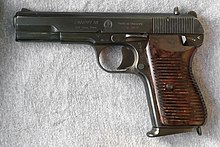
The Hungarian 'Tokagypt-58' - is a 9 mm variant of the Soviet TT pistol
Hungary rebarreled the TT to fire ix×19mm Parabellum equally the M48, as well equally an consign version for Egypt known as the Tokagypt 58 which was widely used by police forces there.[12] Tokagypts differ from the original Tokarevs past an external safety lever that tin can be engaged in safety decocking as well as cocked hammer position. By changing the barrel and mag into original TT parts, a calibre change system tin can exist made hands (after proof-shooting in countries affiliated with the CIP).
Egypt, still, cancelled much of the order of the Tokagypt and PP-like pistols manufactured in Hungary; those were marketed then in the West, like the then Frg, where it was imported by Hege.
North Korea [edit]
Northward Korea manufactured them every bit the Blazon 68 [14] or M68.[12]
Pakistan [edit]
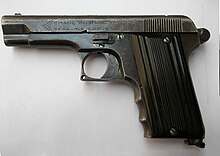
A crude Pakistani-made knockoff copy of the TT-33 Pistol.
Both legal and illegal TT pistols are however manufactured in various Pakistani Khyber Pass factories.[15]
Poland [edit]
Poland produced their own copies as the Pow wz.33, manufactured from 1947 to 1959.[12] In mid-50s a training version of PW wz. 33 was created, chambered in .22lr called TT Sportowy. All of those pistols were converted between 1954 and 1958 from the vii.62mm variant by changing the butt and removing the locking lugs from slide.
Additionally, the Radom M48 was created in Radom, Poland as some other slightly modified copy of the TT33.
Romania [edit]
Romania produced a TT-33 copy equally the TTC, or Tokarev Cugir well into the 1950s. These have been made available for commercial sale in great numbers in recent years. Even so, to exist importable into the United States, a trigger blocking safety was added.[sixteen]
Vietnam [edit]
The K54 is a copy of the TT-33.[17] An updated version known as the K14-VN is made by Manufactory Z111, and has an increased capacity of 13 rounds, with a wider grip to incorporate a double stack mag.[17] [18] Research and evolution started in 2001.[19] The K14-VN began to see service with PAVN forces on May 10, 2014.[20]
The industry name for the regular K54 and the K14-VN is known as SN7M and the SN7TD.[21]
Yugoslavia (Serbia) [edit]

The Yugoslavian M57 variant with loaded ix-round mag.
Zastava produces an improved version of the TT-33 designated M57.
The M57 has a longer grip and longer 9-round magazine (versus 8 rounds in TT). A nine×19mm version is also made past Zastava designated M70A likewise as a compact version M88.
Zastava manufactures a sub compact pistol M70 (a.grand.a.Pčelica ("footling bee")) roughly based on TT design in 7,65mm Browning (.32 ACP) or 9mm Kratak (.380 ACP).[ citation needed ]
Since 2012, the M57A, M70A and M88A was formerly imported into the U.South. by Century International Arms, but has since been replaced by Zastava USA.[22] [23]
Usage [edit]
The TT-33 is still in service in the Bangladeshi and N Korean military today, while police in Pakistan still normally utilize the TT pistol as a sidearm, though unofficially, every bit it is being replaced by modern 9 mm Beretta and SIG Sauer pistols. In China, the TT-33 pistol is also occasionally supplied to the People's Armed Police and People'southward Liberation Army under the proper noun Blazon 54.[24]
The Tokarev, besides as its variants in 9mm, take been renowned for their simplicity, power and accuracy.[25]
Users [edit]

Tokarev Pistol historical usage map
Meet as well [edit]
- List of Russian weaponry
- Table of handgun and rifle cartridges
References [edit]
- ^ Russian: 7,62-мм самозарядный пистолет Токарева образца 1930 года, romanized: 7,62 mm Samozaryadny Pistolet Tokareva obraztsa 1930 goda , "7.62 mm Tokarev self-loading pistol model 1930", TT stands for Tula-Tokarev)
- ^ Rottman, Gordon L. (December 2002). Korean War Lodge of Battle: United States, United Nations, and Communist Ground, Naval, and Air Forces, 1950-1953. Praeger. p. 198. ISBN978-0-275-97835-viii. Archived from the original on 2018-12-09. Retrieved 2018-12-07 .
- ^ Katz, Sam (24 Mar 1988). Arab Armies of the Middle Eastward Wars (2) . Men-at-Arms 128. Osprey Publishing. p. 39. ISBN9780850458008.
- ^ "Artillery for liberty". 29 December 2017. Retrieved 2019-08-31 .
- ^ Schmidl, Erwin; Ritter, László (ten November 2006). The Hungarian Revolution 1956 . Aristocracy 148. Osprey Publishing. p. 45. ISBN9781846030796.
- ^ Minor Arms Survey (2012). "Surveying the Battlefield: Illicit Artillery In Afghanistan, Iraq, and Somalia". Small Arms Survey 2012: Moving Targets. Cambridge University Press. p. 332. ISBN978-0-521-19714-iv. Archived from the original (PDF) on 2018-08-31. Retrieved 2018-08-30 .
- ^ a b Ferguson, Jonathan; Jenzen-Jones, North.R. (2014). "Raising Red Flags: An Exam of Arms & Munitions in the Ongoing Conflict in Ukraine. (Research Study No. 3)" (PDF). ARES. p. 86. Retrieved 28 May 2020.
- ^ Monetchikov, Southward. (Dec 2007). "АРСЕНАЛ: ТТ: МАЛЕНЬКОЕ РУССКОЕ ЧУДО" [TT: Minor Russian phenomenon]. "Bratishka" mag. Archived from the original on 15 January 2015.
- ^ Globe.guns.ru. "Tokarev TT pistol (USSR/Russian federation)". Archived from the original on 2008-04-05. Retrieved 2008-01-29 .
- ^ a b Cruffler.com (March 2001). "Polish M48 (Tokarev TT-33) Pistols". Archived from the original on 2008-01-31. Retrieved 2008-01-29 .
- ^ Tokarev, Vladimir (2000). "Fedor V. Tokarev". Archived from the original on 2008-01-31. Retrieved 2008-01-29 .
- ^ Henrotin, Gerard (2002). Soviet Military Pistols - Tokarev & Makarov. p. 9.
- ^ a b c d e f Bishop, Chris (2006). The Encyclopedia of Small Arms and Artillery. Grange Books. pp. 13–14. ISBN978-1-84013-910-five.
- ^ Kokalis, Peter (Jan 2001). Weapons Tests And Evaluations: The Best Of Soldier Of Fortune. Boulder, Colorado, USA: Paladin Press. p. 96. ISBN978-1-58160-122-0.
- ^ "Modern Firearms". Archived from the original on 8 August 2010. Retrieved 14 Nov 2014.
- ^ "The Fashion of the Gun: The legendary gunsmiths of Darra Adam Khel". Riaz Ahmed. Express Tribune. Archived from the original on 2016-xi-16. Retrieved 2016-xi-16 .
- ^ Lawrence, Erik (2015-03-13). Practical Guide to the Operational Utilise of the TT-33 Tokarev Pistol. Erik Lawrence Publications. ISBN9781941998267.
- ^ a b "K14-VN - Modern Firearms". guns.ru. xix December 2015. Archived from the original on 23 November 2016. Retrieved i April 2018.
- ^ "Sức mạnh dàn súng Việt Nam tự sản xuất". baodatviet.vn. Archived from the original on 7 Dec 2017. Retrieved i April 2018.
- ^ "Sức mạnh dàn súng Việt Nam tự sản xuất". baodatviet.vn. Archived from the original on 7 December 2017. Retrieved ane April 2018.
- ^ "Archived re-create". Archived from the original on 2016-eleven-04. Retrieved 2016-11-03 .
{{cite web}}: CS1 maint: archived copy every bit championship (link) - ^ "Archived copy". Archived from the original on 2018-12-01. Retrieved 2018-12-01 .
{{cite web}}: CS1 maint: archived copy as championship (link) - ^ "Archived re-create". Archived from the original on 2019-04-20. Retrieved 2019-03-19 .
{{cite web}}: CS1 maint: archived copy equally title (link) - ^ "Archived re-create". Archived from the original on 2019-04-20. Retrieved 2019-03-19 .
{{cite spider web}}: CS1 maint: archived copy as title (link) - ^ Lawrence, Erik (2015-03-xiii). Practical Guide to the Operational Utilize of the TT-33 Tokarev Pistol. Erik Lawrence Publications. ISBN9781941998267.
- ^ Sergey (April i, 2002). Williams, Trip (ed.). "Tokarev 213: A Chinese variant of the Soviet Tokarev". Alpha Rubicon. Archived from the original on Feb eight, 2018. Retrieved February 14, 2018.
- ^ a b c d e f grand h i j k l m northward o p q r south t u v due west x y z aa ab ac advertisement ae af ag ah ai aj ak al am an Jones, Richard D. Jane'due south Infantry Weapons 2009/2010. Jane's Information Group; 35 edition (January 27, 2009). ISBN 978-0-7106-2869-five.
- ^ Small Arms Survey (2007). "Armed Violence in Burundi: Conflict and Post-Conflict Bujumbura" (PDF). The Small Artillery Survey 2007: Guns and the City. Cambridge University Press. p. 204. ISBN978-0-521-88039-8. Archived from the original on 2018-08-27. Retrieved 2018-08-29 .
- ^ a b c Marchington, James (2004). The Encyclopedia of Handheld Weapons. Lewis International, Inc. ISBN ane-930983-xiv-10.
- ^ Hogg, Ian (2002). Jane's Guns Recognition Guide. Jane'south Information Grouping. ISBN 0-00-712760-X.
- ^ a b "FINNISH ARMY 1918 - 1945: REVOLVERS & PISTOLS Function 2". www.jaegerplatoon.net. Archived from the original on 23 April 2018. Retrieved 1 Apr 2018.
- ^ a b c d e "Modern Firearms". Archived from the original on one Dec 2014. Retrieved 14 November 2014.
- ^ "40 Prajurit Korem Bhaskara Jaya Diminta Tingkatkan Kemampuan Menembak". timesindonesia.co.id (in Indonesian). 17 March 2020. Retrieved 10 November 2021.
- ^ Anders, Holger (June 2014). Identifier les sources d'approvisionnement: Les munitions de petit calibre en Côte d'Ivoire (PDF) (in French). Small Artillery Survey and Un Operation in Côte d'Ivoire. p. 15. ISBN978-ii-940-548-05-vii. Archived from the original (PDF) on 2018-10-09. Retrieved 2018-09-05 .
- ^ Small Arms Survey (2012). "Blue Skies and Dark Clouds: Kazakhstan and Small Arms". Modest Artillery Survey 2012: Moving Targets. Cambridge Academy Press. p. 131. ISBN978-0-521-19714-4. Archived from the original (PDF) on 2018-08-31. Retrieved 2018-08-30 .
- ^ Small Arms Survey (2005). "Sourcing the Tools of War: Small Arms Supplies to Conflict Zones". Small Arms Survey 2005: Weapons at War. Oxford Academy Press. p. 166. ISBN978-0-19-928085-8. Archived from the original (PDF) on 2018-08-30. Retrieved 2018-08-29 .
- ^ "Weapon". Archived from the original on 21 December 2014. Retrieved 14 November 2014.
- ^ "Archived copy" (PDF). Archived (PDF) from the original on 2016-03-04. Retrieved 2015-04-04 .
{{cite spider web}}: CS1 maint: archived re-create as championship (link) - ^ //silahreport.com/2017/12/31/tokarev-7-62-x-25-local-made/
- ^ Smith, Chris (October 2003). In the Shadow of a End-fire: The Impacts of Minor Artillery Availability and Misuse in Sri Lanka (PDF). Small Artillery Survey. Archived from the original (PDF) on 2017-07-05. Retrieved 2017-eleven-07 .
- ^ Peter Abbott (1986). Modernistic African Wars (1) 1965-eighty . p. 10. ISBN0850457289.
External links [edit]
Tt 33 Vs 1911 Size Comparison Airsoft
Posted by: hendersonhichat.blogspot.com
0 Response to "Tt 33 Vs 1911 Size Comparison Airsoft"
Post a Comment